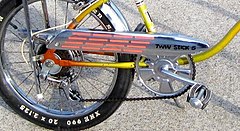
A bicycle, also called a pedal cycle, bike, push-bike or cycle, is a human-powered or motor-powered assisted, pedal-driven, single-track vehicle, having two wheels attached to a frame, one behind the other. A bicycle rider is called a cyclist, or bicyclist.

A mountain bike (MTB) or mountain bicycle is a bicycle designed for off-road cycling. Mountain bikes share some similarities with other bicycles, but incorporate features designed to enhance durability and performance in rough terrain, which makes them heavier, more complex and less efficient on smooth surfaces. These typically include a suspension fork, large knobby tires, more durable wheels, more powerful brakes, straight, extra wide handlebars to improve balance and comfort over rough terrain, and wide-ratio gearing optimised for topography and application. Rear suspension is ubiquitous in heavier-duty bikes and now common even in lighter bikes. Dropper posts can be installed to allow the rider to quickly adjust the seat height.

The penny-farthing, also known as a high wheel, high wheeler or ordinary, is an early type of bicycle. It was popular in the 1870s and 1880s, with its large front wheel providing high speeds and comfort.

A bicycle frame is the main component of a bicycle, onto which wheels and other components are fitted. The modern and most common frame design for an upright bicycle is based on the safety bicycle, and consists of two triangles: a main triangle and a paired rear triangle. This is known as the diamond frame. Frames are required to be strong, stiff and light, which they do by combining different materials and shapes.
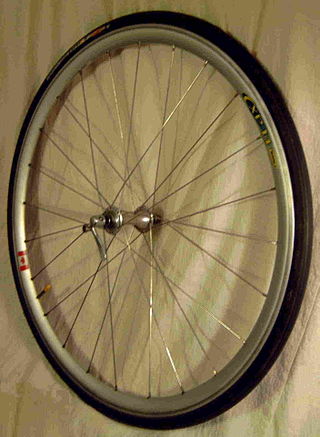
A bicycle wheel is a wheel, most commonly a wire wheel, designed for a bicycle. A pair is often called a wheelset, especially in the context of ready built "off the shelf" performance-oriented wheels.
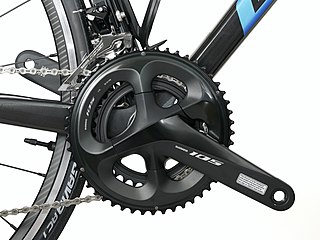
The crankset or chainset, is the component of a bicycle drivetrain that converts the reciprocating motion of the rider's legs into rotational motion used to drive the chain or belt, which in turn drives the rear wheel. It consists of one or more sprockets, also called chainrings or chainwheels attached to the cranks, arms, or crankarms to which the pedals attach. It is connected to the rider by the pedals, to the bicycle frame by the bottom bracket, and to the rear sprocket, cassette or freewheel via the chain.

A bicycle chain is a roller chain that transfers power from the pedals to the drive-wheel of a bicycle, thus propelling it. Most bicycle chains are made from plain carbon or alloy steel, but some are nickel-plated to prevent rust, or simply for aesthetics.

A utility bicycle,city bicycle, urban bicycle, European city bike (ECB), Dutch bike, classic bike or simply city-bike, is a bicycle designed for frequent very short, very slow rides through very flat urban areas. It is a form of utility bicycle commonly seen around the world, built to facilitate everyday short-distance riding in normal clothes in cold-to-mild weather conditions. It is therefore a bicycle designed for very short-range practical transportation, as opposed to those primarily for recreation and competition, such as touring bicycles, racing bicycles, and mountain bicycles. Utility bicycles are the most common form globally, and comprise the vast majority found in the developing world. City bikes may be individually owned or operated as part of a public bike sharing scheme.
Hybrid bicycles blend characteristics from more specialized road bikes, touring bikes and mountain bikes. The resulting "hybrid" is a general-purpose bike that can tolerate a wide range of riding conditions and applications. Their stability, comfort and ease of use make them popular with novice cyclists, casual riders, commuters, and children.
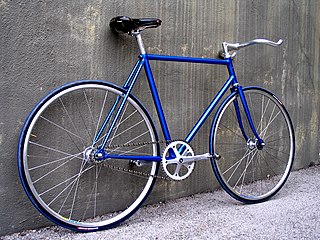
A fixed-gear bicycle is a bicycle that has a drivetrain with no freewheel mechanism such that the pedals always will spin together with the rear wheel. The freewheel was developed early in the history of bicycle design but the fixed-gear bicycle remained the standard track racing design. More recently the "fixie" has become a popular alternative among mainly urban cyclists, offering the advantage of simplicity compared with the standard multi-geared bicycle.
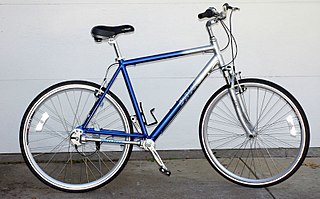
A shaft-driven bicycle is a bicycle that uses a drive shaft instead of a chain to transmit power from the pedals to the wheel. Shaft drives were introduced in the 1880s, but were mostly supplanted by chain-driven bicycles due to the gear ranges possible with sprockets and derailleurs. Around the 2000s, due to advancements in internal gear technology, a small number of modern shaft-driven bicycles have been introduced.
SR SunTour is a Taiwanese manufacturer of bicycle components, formed in 1988 when Osaka based SunTour (Maeda) went bankrupt and was purchased by Sakae Ringyo Company, a major Japanese maker of aluminum parts, particularly cranks and seat posts. SunTour's sales and commercial success peaked from the late 1970s to the mid-1980s.

A fork end, fork-end, or forkend is a slot in a bicycle frame or bicycle fork where the axle of a bicycle wheel is attached. A dropout is a type of fork end that allows the rear wheel to be removed without first derailing the chain.

On a bicycle, the cassette or cluster is the set of multiple sprockets that attaches to the hub on the rear wheel. A cogset works with a rear derailleur to provide multiple gear ratios to the rider. Cassettes come in two varieties, freewheels or cassettes, of which cassettes are a newer development. Although cassettes and freewheels perform the same function and look almost the same when installed, they have important mechanical differences and are not interchangeable.

Sheldon Brown was an American bicycle mechanic, technical expert and author. He contributed to print and online sources related to bicycling and bicycle mechanics, in particular the web site Sheldon Brown's Bicycle Technical Info. His knowledge of bicycles was described as "encyclopaedic" by The Times of London.
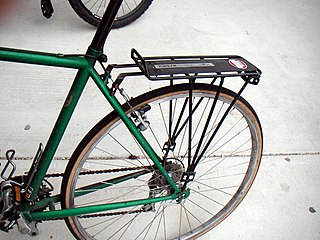
A luggage carrier, also commonly called a (bicycle)rack, is a device attached to a bicycle to which cargo or panniers can be attached. This is popular with utility bicycles and touring bicycles.

The following outline is provided as an overview of and topical guide to bicycles:

A master link or quick-release link is a roller chain accessory that allows convenient connection and disconnection of a chain without the need for a chain tool. It acts as a set of the chain's outer plates, so joining two sets of the chain's inner plate ends. Such master links may or may not be re-usable. A chain tool is nonetheless needed to adjust a chain's length, for example to shorten a new chain before connecting its ends. They are used on bicycles and motorcycles.


